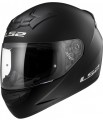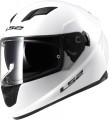Features
—
Quick release visor. The ability to quickly remove the helmet visor, in most cases without the use of special tools. Such an opportunity can be useful, for example, for cleaning from pollution, replacing transparent glass with tinted glass, or vice versa.
—
Anti-fog coating. The presence on the helmet visor of a special coating that prevents fogging from the breath of a motorcyclist. This feature will be useful especially in cold weather (glasses practically do not sweat at high air temperatures). It is especially important for closed helmets (integral and enduro, see "Type"), but can also be found in open ones. Note that such a coating is not a 100% guarantee against fogging, but the likelihood of this phenomenon is greatly reduced.
—
Sun visor. A sunscreen in the form of additional tinted glasses that can be lowered and raised as needed, usually by means of a small lever or button on the side of the helmet. Do not confuse this device with tinted glass (see "Visor" above): a sun visor is provided as an addition to the main visor and covers only the eyes. By lowering and raising such glasses, you can “turn on” and “turn off” additional dimming. At the same time, the main visor is most often made transparent, thanks to which the helmet can be comfortably used at night — just lift the built-in glasses and look through the transparent glass. However,
...the sun visor can also be combined with tinted glass; this option will be appreciated by people with sensitive eyes that do not tolerate sunlight well and require enhanced darkening. The disadvantage of this feature is a noticeable increase in the cost of the helmet.
— UV protection. Availability of UV protection in the glass and/or helmet sun visor (see above). Intense ultraviolet light is harmful to the eyes, it leads to their rapid fatigue, deterioration of vision, and sometimes even eye diseases. Moreover, such radiation can be quite intense not only in sunny, but even in cloudy weather; in addition, the amount of ultraviolet increases in mountainous areas as altitude increases. However with short-term exposure, the described effects are hardly noticeable, but even for trips over short distances, UV protection will be useful. And if you are going to travel "far and long" — this feature is highly desirable. Note that if necessary, UV protection can be provided using separate glasses (motorcycle or conventional), but not all helmets allow the use of such glasses.
— Built-in ventilation. The ventilation system usually has the form of holes in the shell — the air flow entering them "blows" the inside of the helmet. This not only provides comfort (especially in hot weather), but also reduces the amount of moisture accumulating inside: the rider's head sweats less than in a fully closed helmet, and the sweat that is released quickly evaporates and is blown into the ventilation. At the same time, many models provide the ability to completely or partially block the ventilation — for example, in cold or rainy weather.
— Breath cutter. Most often found in helmets of a closed design (integrals, modulars, enduro — see "Type"). In such models, it is a kind of visor that covers the nose and mouth of the motorcyclist — so that the exhaled air is discharged into the lower part of the helmet and the visor does not fog up. Also, sometimes cut-offs are called additional masks that are equipped with open helmets, but this is not entirely true — such masks have a slightly different purpose, they are mainly designed to protect the mouth and nose from dust, small litter, insects, etc.SHARP safety rating
The results shown by this helmet model in the SHARP safety rating.
SHARP is a comprehensive testing methodology designed to determine the degree of protection and safety level when using a helmet. Each helmet is tested for direct (linear) impact as well as glide impact friction; in the first case, the acceleration acting on the motorcyclist's brain is measured, in the second, the twisting force acting on the neck is also measured. Tests are conducted for different points of impact, each test involves a minimum of 32 test collisions (more if necessary). The data obtained is compared with information about real injuries, and based on this, the helmet is rated on a five-point scale — from 1 to 5 stars.
The higher the SHARP rating, the safer the helmet and the lower the chance of serious injury while wearing it. However, when choosing this parameter, it is worth considering some nuances. First, the SHARP check is only done on models sold in the UK; and therefore the absence of such certification does not mean poor protection — it may indicate that the helmet simply did not make it to the test. Secondly, the cost of a helmet practically does not affect the number of stars: neither 5 stars for a low-cost model, nor 2-3 stars for a top one are rare. Thirdly, the SHARP programme only checks safety in collisions, it does not affect issues of convenience, aerodynamics, visibility, etc. And even the SHARP experts themselves recommend choosing the most conveni...ent models first, and only then choosing the option with the highest number of stars.

